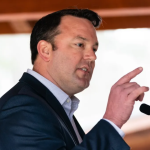Atlanta, GA — On February 5, 2025, the steps of the Georgia State Capitol became a focal point for dissent as hundreds of protesters gathered to voice their opposition to President Donald Trump’s recent policy actions and the controversial Project 2025 initiative.
This demonstration was part of a coordinated series of protests occurring simultaneously across all 50 states, unified under the banner “50501”—representing 50 protests in 50 states on one day.
Nationwide Movement
The “50501” movement emerged in response to a series of executive orders and policy proposals from the Trump administration that critics argue undermine civil liberties and social justice.
In cities from Philadelphia to Austin, demonstrators took to the streets, decrying policies ranging from immigration crackdowns to the rollback of transgender rights.
The Associated Press reported that these protests were a direct reaction to the administration’s early actions, which many view as aggressive and discriminatory.
Focus on Project 2025
Central to the protests is Project 2025, a comprehensive 922-page policy blueprint developed by conservative think tanks, notably the Heritage Foundation.
The project outlines a vision for reshaping the federal government, emphasizing a consolidation of executive power and significant policy shifts in areas such as immigration, environmental regulation, and social services.
While President Trump distanced himself from the project during his campaign, stating he was unaware of its contents, many of his administration’s early actions align closely with its proposals.
Atlanta’s Demonstration
In Atlanta, the protest commenced around 2 p.m., with demonstrators assembling at Centennial Olympic Park before marching to the Georgia State Capitol.
Participants chanted slogans and held signs criticizing President Trump, Elon Musk—appointed as the head of the newly established Department of Government Efficiency—and the administration’s immigration policies.
Local news outlet 11Alive reported that the crowd was diverse, encompassing individuals from various backgrounds united in their opposition to the current administration’s direction.
Voices from the Crowd
Among the protesters was Maria Gonzalez, a 34-year-old teacher from Atlanta, who expressed her concerns:
“I’m here because the policies being implemented are tearing families apart and sowing fear in our communities. This isn’t the America I know.”
Similarly, James Thompson, a veteran and small business owner, highlighted his apprehension regarding Project 2025:
“The consolidation of power outlined in Project 2025 threatens the checks and balances that are fundamental to our democracy. We cannot stand by and let this happen.”
Policy Implications
Since taking office, President Trump has signed a series of executive orders that critics argue exceed even the ambitious scope of Project 2025.
These actions include halting U.S. aid abroad, fortifying the southern border, and imposing restrictions on transgender athletes.
Reuters identified more than a dozen such policy moves that surpass the project’s original recommendations.
Furthermore, the administration’s approach to criminal justice has raised alarms. Teen Vogue reported a series of regressive actions focusing on harsh measures against immigrants and the reversal of previous reforms.
This includes reestablishing private federal prison contracts and ending the federal death penalty moratorium. Ironically, while enforcing stringent policies, President Trump pardoned numerous participants of the January 6th Capitol riot, highlighting a selective approach to “law and order.”
Read More:
- Mayor Erin Mendenhall Appoints Brian Redd as New Police Chief of Salt Lake City
- SLCPD Utilizes Drone Technology to Capture Suspects in Jordan River Trail Enforcement
Public Response and Future Actions
The widespread protests reflect a growing public dissent against the administration’s trajectory.
Organizers of the “50501” movement have indicated that this is just the beginning of sustained efforts to challenge policies they view as detrimental to the nation’s fabric.
Plans are underway for continued demonstrations, community organizing, and legal challenges to counteract the administration’s agenda.
As the nation grapples with these contentious issues, the coming months are poised to be a critical period of civic engagement and activism.
The protests in Atlanta and across the country signify a robust exercise of democratic rights, emphasizing the populace’s role in shaping the nation’s future.
Official Responses
In response to the protests, White House Press Secretary Jane Doe stated:
“The administration is committed to implementing policies that prioritize national security and economic prosperity. While we respect the right to peaceful protest, we believe our actions are in the best interest of the American people.”
Meanwhile, local authorities in Atlanta reported that the demonstrations remained peaceful, with no significant incidents.
Police presence was noticeable but unobtrusive, ensuring the safety of both protesters and bystanders.
Looking Ahead
The convergence of policy implementation and public opposition sets the stage for a dynamic and potentially turbulent political landscape.
As the Trump administration continues to advance its agenda, it faces a populace increasingly willing to mobilize and advocate for their vision of America’s future.
The efficacy of these protests and their impact on policy remain to be seen, but the message from the streets of Atlanta and beyond is unequivocal: a significant segment of the American public is prepared to stand up and make their voices heard.
Disclaimer- Our team has thoroughly fact-checked this article to ensure its accuracy and maintain its credibility. We are committed to providing honest and reliable content for our readers.






















+ There are no comments
Add yours